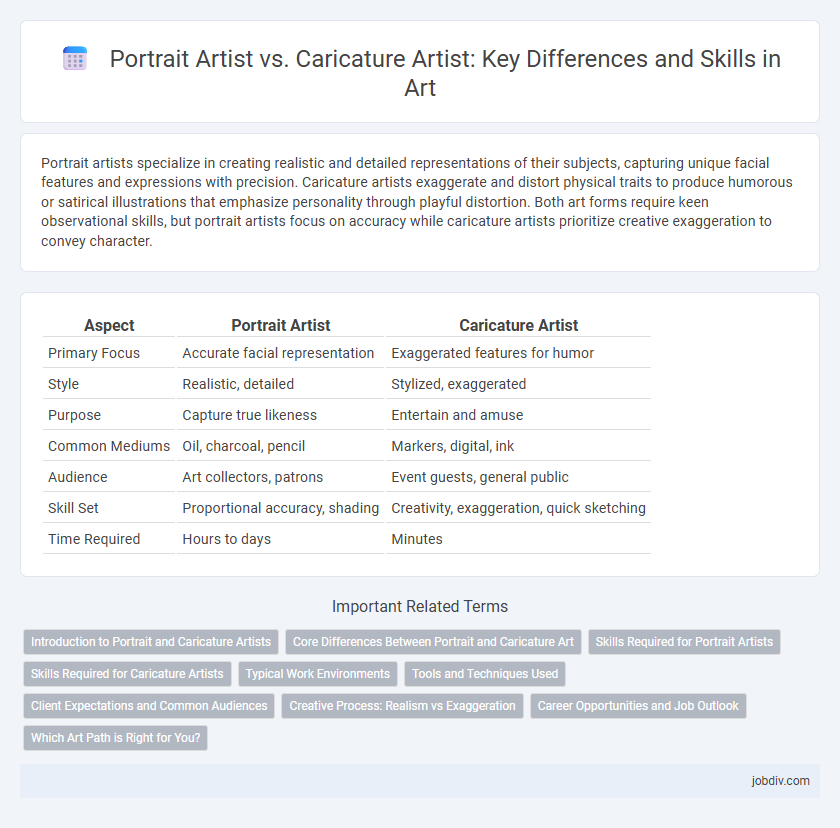Portrait artists specialize in creating realistic and detailed representations of their subjects, capturing unique facial features and expressions with precision. Caricature artists exaggerate and distort physical traits to produce humorous or satirical illustrations that emphasize personality through playful distortion. Both art forms require keen observational skills, but portrait artists focus on accuracy while caricature artists prioritize creative exaggeration to convey character.
Table of Comparison
| Aspect | Portrait Artist | Caricature Artist |
|---|---|---|
| Primary Focus | Accurate facial representation | Exaggerated features for humor |
| Style | Realistic, detailed | Stylized, exaggerated |
| Purpose | Capture true likeness | Entertain and amuse |
| Common Mediums | Oil, charcoal, pencil | Markers, digital, ink |
| Audience | Art collectors, patrons | Event guests, general public |
| Skill Set | Proportional accuracy, shading | Creativity, exaggeration, quick sketching |
| Time Required | Hours to days | Minutes |
Introduction to Portrait and Caricature Artists
Portrait artists specialize in capturing the realistic likeness and personality of their subjects through detailed and precise techniques. Caricature artists emphasize exaggeration and humor, distorting distinctive features to create playful and often satirical representations. Both art forms require keen observation skills, but they serve different purposes: the former aims for authenticity, while the latter prioritizes expression and entertainment.
Core Differences Between Portrait and Caricature Art
Portrait artists prioritize realistic representation and accurate depiction of facial features, capturing personality through fine detail and proportion. Caricature artists exaggerate distinctive features to create humorous or satirical effects, emphasizing expression over realism. The core difference lies in intent: portrait art aims for likeness and subtlety, while caricature art focuses on exaggeration and playful distortion.
Skills Required for Portrait Artists
Portrait artists require advanced skills in realistic rendering, precise anatomical knowledge, and mastery of lighting and shading to capture true likeness and emotion. Their expertise includes detailed observation of facial features, skin textures, and subtle expressions, demanding patience and fine motor control. Unlike caricature artists who exaggerate traits for humor, portrait artists strive for accuracy and depth, emphasizing proportionality and color harmony.
Skills Required for Caricature Artists
Caricature artists require exceptional skills in exaggeration and simplification to capture distinctive facial features while maintaining likeness. Mastery in anatomy, keen observation, and the ability to convey humor or satire through expressive lines and bold colors are fundamental. Proficiency in fast sketching techniques and adaptability to various media enhance their capacity to produce engaging and instantly recognizable caricatures.
Typical Work Environments
Portrait artists typically work in studios or controlled settings where lighting and composition can be precisely managed to capture accurate likenesses. Caricature artists often perform in dynamic environments such as fairs, theme parks, or street corners, engaging live audiences with spontaneous and exaggerated representations. These differing work environments influence their techniques, tools, and interaction styles with subjects.
Tools and Techniques Used
Portrait artists primarily utilize graphite pencils, charcoal, and oil paints to capture realistic facial features with precise shading and blending techniques. Caricature artists favor exaggerated lines, bold markers, and digital tablets to emphasize distinctive traits through stylized distortions and rapid sketching methods. Both disciplines require mastery in anatomy and expression but differ significantly in tool choice and artistic approach to visual storytelling.
Client Expectations and Common Audiences
Portrait artists typically meet client expectations by capturing realistic likenesses and subtle expressions, appealing to those seeking formal, timeless representations for personal or professional use. Caricature artists focus on exaggerating distinctive features to create humorous, playful interpretations, attracting audiences at events, parties, and casual gatherings where entertainment is a priority. Both artists tailor their work to distinct client desires, balancing accuracy and creativity to satisfy varying audience preferences in the art market.
Creative Process: Realism vs Exaggeration
Portrait artists emphasize realism by capturing accurate facial features and subtle expressions through detailed observation and precise brushwork. Caricature artists prioritize exaggeration, amplifying distinctive traits to create humorous or satirical representations that convey personality and emotion through distortion. Both creative processes require advanced skills in anatomy and observation but diverge in their goals of fidelity versus exaggerated interpretation.
Career Opportunities and Job Outlook
Portrait artists typically find career opportunities in fine art galleries, private commissions, and corporate branding, emphasizing realistic, detailed representations that appeal to a broad clientele. Caricature artists often have versatile roles in entertainment, events, and digital media, capitalizing on exaggerated, humorous depictions that attract diverse audiences and have growing demand in social media content creation. Job outlooks for portrait artists remain steady with niche markets, while caricature artists benefit from expanding platforms offering dynamic, interactive experiences and freelance flexibility.
Which Art Path is Right for You?
Choosing between a portrait artist and a caricature artist depends on your artistic goals and style preferences. Portrait artists focus on realism and capturing accurate likenesses, ideal for those who enjoy detailed, representational work. Caricature artists exaggerate features to create humorous or exaggerated depictions, perfect for creatives interested in playful, expressive art.
Portrait Artist vs Caricature Artist Infographic

 jobdiv.com
jobdiv.com